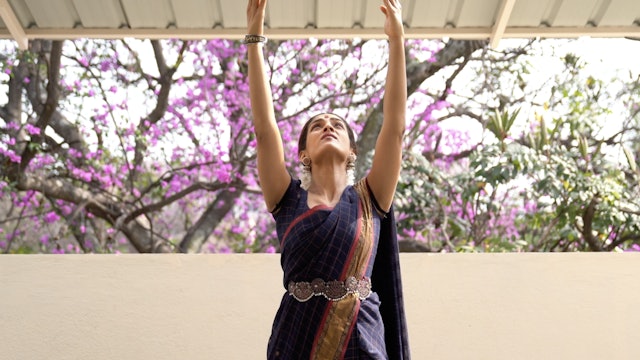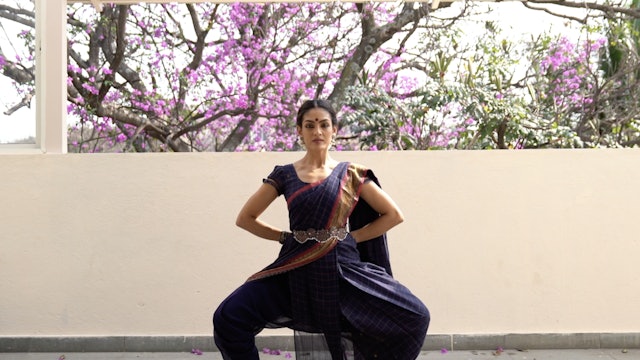-
Hastakaranas Introduction
The movements of the wrists and fingers according to the Nātyasāstra.
-
Hastakarana Shloka
The movements of the wrists and fingers according to the Nātyasāstra.
apaveśtithameka syāth udveśtithamathaparam
vyāvartitam tritīyantu ćaturtham parivartitamapaveśtitham
udveśtitham
vyāvartitam
parivartitam -
Grīva bheda Introduction
The neck movements are considered one of the Mukhaja, or gestures of the face according to the Nātyasāstra.
The movements are used primarily to communicate meaning in the context of gesture.
-
Grīva bheda Shloka
The neck movements are considered one of the Mukhaja, or gestures of the face according to the Nātyasāstra.
The movements are used primarily to communicate meaning in the context of gesture.
Please refer to the Shloka below for pronunciation. Please note that the separate movements of the neck ...
-
Bru bheda Introduction
The eyebrows are considered one of the Mukhaja, or gestures of the face according to the Nātyasāstra.
The movements are used primarily to communicate meaning in the context of gesture.
-
Bru bheda Shloka
The eyebrow movements are considered one of the Mukhaja, or gestures of the face according to the Nātyasāstra.
The movements are used primarily to communicate meaning in the context of gesture.
Please refer to the Shloka below for pronunciation. Please note that the separate movements of the he...
-
Driśti bheda Introduction
The eye movements are considered one of the Mukhaja, or gestures of the face according to the Nātyasāstra.
The movements are used primarily to communicate meaning in the context of gesture.
-
Driśti bheda Shloka
The eye movements are considered one of the Mukhaja, or gestures of the face according to the Nātyasāstra.
The movements are used primarily to communicate meaning in the context of gesture.
Please refer to the Shloka below for pronunciation. Please note that the separate movements of the head w...
-
Shiro bheda Shloka
The head is considered one of the Angas, or major limbs according to the Natyashastra.
The movements of the head are used not only for the precise control in the execution of Nritta but also to communicate meaning in the context of gesture.
Please refer to the Shloka below for pronunciation. ...
-
Pārśva Bheda Shloka
The side, Parshva is considered one of the Angas, or major limbs according to the Natyashastra.
The movements of the side are used not only for the precise control in the execution of Nritta but also to communicate meaning in the context of gesture.
Please refer to the Shloka below for pronun...
-
Urō bheda Shloka
The chest or Uras is considered one of the Angas according to the Natyashastra. The movements of the chest are used not only for the precise control in the execution of Nritta but also to communicate meaning in the context of gesture.
Please refer to the Shloka below for pronunciation. Please no...
-
Katī bheda Shloka
The hips are considered one of the Angas, or major limbs according to the Natyashastra.
The movements of the hips and waist are used not only for the precise control in the execution of Nritta but also to communicate meaning in the context of gesture.
Please refer to the Shloka below for pronun...
-
Pādah bheda Shloka
The feet are considered one of the Angas, or major limbs according to the Natyashastra.
The movements of the feet are used not only for the precise control in the execution of Nritta but also to communicate meaning in the context of gesture.
Please refer to the Shloka below for pronunciation. P...
-
Bāhu bheda Shloka
The arms considered one of the Upāngas, or minor limbs.
The movements are used primarily to communicate meaning in the context of gesture and also clear articulation in dance or nritta.
Please refer to the Shloka below for pronunciation. Please note that the separate movements of the head when...
-
Udara bheda Shloka
The stomach is considered one of the Upāngas, or minor limbs.
The movements are used primarily to communicate meaning in the context of gesture.
Please refer to the Shloka below for pronunciation. Please note that the separate movements of the head when put together in a Shloka form 'Sandhis', ...
-
Ūru bheda Shloka
The thighs are considered one of the Upāngas, or minor limbs according to the Natyashastra.
The movements of the thighs are used not only for the precise control in the execution of Nritta but also to communicate meaning in the context of gesture.
Please refer to the Shloka below for pronunciat...
-
Jānu bheda Shloka
Jānu bheda according to the Sangīta Ratnākara, is an Upānga. The knees are considered one of the minor limbs.
The movements of the knees are used not only for the precise control in the execution of Nritta but also to communicate meaning in the context of gesture. Some of the positions elucidate...
-
Janghā bheda Shloka
The shins/ shanks are considered one of the Upāngas, or minor limbs according to the Nātyaśāstra
The movements are used not only for the precise control in the execution of Nritta but also to communicate meaning in the context of gesture.
Please refer to the Shloka below for pronunciation. Plea...
-
Pārśni bheda Shloka
The heels are considered one of the Upāngas, or minor limbs
The movements are used not only for the precise control in the execution of Nritta but also to communicate meaning in the context of gesture.
Please refer to the Shloka below for pronunciation. Please note that the separate movements ...
-
Gulphā bheda Shloka
The Ankle is considered one of the Upāngas, or minor limbs according to the Sangīta Ratnākara.
The movements of the ankle are important in pure dance and in emotive contexts.
Please refer to the Shloka below for pronunciation. Please note that the separate movements of the head when put togethe...
-
Thala bheda Shloka
The soles of the feet are considered one of the Upāngas, or minor limbs.
The movements are used not only for the precise control in the execution of Nritta but also to communicate meaning in the context of gesture.
Please refer to the Shloka below for pronunciation. Please note that the separat...
-
Purusha Sthāna
Though the Sthānakās, or static positions for male and female characters are not limited to be used only by a specific gender, they are the building blocks for Karanas.
There are 6 Sthanakas for male characters.
Vaiśnavam samapādam ća vaiśakham mandalam tathā
pratyālīdam matālīdam sthanān yethā... -
Strī Sthānas
Though the Sthānakās, or static positions for male and female characters are not limited to be used only by a specific gender, they are the building blocks for Karanas.
Āyatam avahittam aśvakrāntamatāpi ća
Strīnām sthānāni kāryāni gatiśvabharaneśu ćaĀyatam
avahittam
aśvakrāntam
























